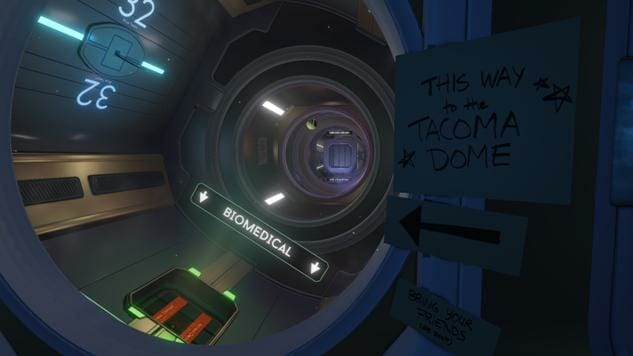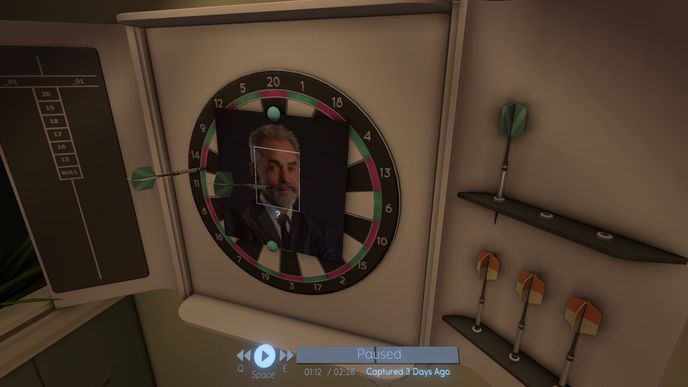
“The challenge with creating something where the point of it is supposed to be engaging with the stuff itself is if you give the player an additional reason, an extrinsic reason, to engage with the stuff, then it actually encourages them to disregard as much of it as possible because they’re only looking for the important thing.” That’s Steve Gaynor, project lead of the upcoming Tacoma, talking about the specific design challenges of the game. Over the course of my half-hour Skype call with Gaynor, we chatted about a lot of different topics, but we kept coming back to something close to this: How do you design a game where the reward is in the engagement itself? How do you ground an entire game experience in the exploration of a space and a story?
Tacoma takes place on an evacuated space station. The player is tasked with retrieving the station’s artificial intelligence by the company owning the station. In doing so, the player encounters 3D recordings of what happened to the crew before the player’s arrival. “As you explore and go about your mission,” Gaynor tells me, “you’re also finding out about who the crew was, what happened to them, and why you were sent here.” Crucially, though, this isn’t told merely through audio recordings or text accounts. Instead, the player is “sharing the space with these characters via 3D recordings that you have control over.”
This is the stuff that the player interacts with. It’s recordings, the positions of people in the past, and the line of causality itself. Like Gone Home before it, developer The Fullbright Company’s previous game, the design challenges of Tacoma seem to center on how one makes the past, and an already-determined future, interesting.
This was the flaw that Paste Games editor Garrett Martin pointed out in his review of The Chinese Room’s Everybody’s Gone to the Rapture. That game also takes place after an event, and the things that the player sees are all in a kind of retrospective flashback as vague 3D figures, but Garrett had this to say about it: if the developers “trusted fully in these characters and their lives, or the audience’s willingness to be fascinated by them without a sci-fi hook, Rapture would have been stronger for it.” Rapture spent too much time pointing at a cause, a science fiction plot hook, rather than making sure that we had an intrinsic interest in what was happening in front of us.
While Tacoma has a similar approach to storytelling (in that figures from the past appear in front of you), Gaynor and company are taking a much more active stance toward how players are interacting with the world around them. In contrast to Rapture’s replays of the past, Tacoma has more “mechanical engagement in how you relate to the scenes you are seeing,” as Gaynor explains. Experiencing the narrative threads of Tacoma is not just about going places and witnessing things, but instead you have to move to different parts of an area and rewind or fast forward through the recording that you’re watching.
The prime motivator of Tacoma seems to be curiosity. Not just what happened, but how, and why? For Gaynor, the design of the game, from top to bottom, seems to exist to engender that curiosity. Instead of a game that demands you to go to X position and get Y key to take to Z door, Tacoma is designed to make you wonder how that key got there and why the door was locked in the first place. Some of that is borrowed from adventure games, and some is borrowed from immersivesims. Ultimately, it provides a set of design principles that scaffolds Tacoma, as Gaynor says:
“Give the player a clear role within the game. Give them strong context for what their role is within the fictional environment. Give them consistent, interactive rules that define both how the environment works and reacts to the player and what the player can do that they can internalize as: ‘Ok, here’s what I’m capable of, here’s why I would be doing that, and here’s how I know the game world will react when I do these things.’”
There is constant evangelism in games around immersion, and that supposedly the conceptual killer app that’s just around the corner in VR. No matter how immersive, though, every game space seems to be on the way to somewhere else. There’s always a puzzle to solve or a key to find; the best-designed room is always on the way to somewhere else. In contrast to those trends, Steve Gaynor is one of the few people I’ve ever talked to who has a design plan for how to put a player in a space and make them genuinely interested in what is happening around them, to make here worth being in instead of a mere gateway to there. And that’s something worth working through.
Cameron Kunzelman tweets at @ckunzelman and writes about games at thiscageisworms.com. His latest game, Epanalepsis, was released last year. It’s available on Steam.
